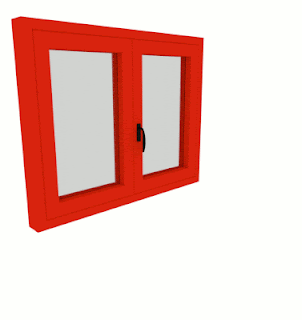UPVC WINDOWS ALWAYS ADAPT TO YOUR NEEDS – PART 2
The number of chambers is not only important value to
follow
The outer wall of the uPVC profiles is usually 2.8-3
mm thick, with the inner cavity of the profile divided by partitions into
several chambers. Usually, more chambers mean better thermal insulation
properties. What is more significant than the number of chambers is the
coefficient of heat transfer through the
frame - the lower the coefficient, the
lower the heat losses across the profile. On the other hand, fewer chambers mean
more space for steel reinforcement, which can then be more massive. The greater
the window size, the higher the requirement is for the static load-bearing
capacity that the metal reinforcement provides. These design elements determine
the maximum size of the windows that can be produced from the profile type.
The uPVC windows are excellently proven both in the
construction of new family houses and in the reconstruction of older houses
because of their variable capabilities.
The connection between the number of chambers and the massive
reinforcement is one of the proofs that uPVC windows cannot be
"simplified" according to one factor.
Seal and ventilate
Another example is a paradoxical situation when too
much tightness of the installed uPVC windows may cause the need of exchange of
air in additional ways. Insufficient ventilation may occur sooner or longer by
mold, headaches, etc. Paradoxically, with respect to reducing the heat loss as
much as possible, the high quality of the window sealant is required, but in
practice we would need a window that it will be able to leak a bit . But even
with this problem, manufacturers can help with different levels of so-called
micro ventilation.
Please note that there are also very interesting
combinations of materials combining the advantages of different materials
today. Examples are uPVC windows with aluminum, a combination that guarantees
excellent physical properties as well as a high aesthetic level.
Speech of standards
One of the primary requirements for windows is to
provide a sufficiently low heat transfer coefficient. For new windows should
not exceed the value of U = 1,7 W / m²K. The recommended value is 1.2 W / m²K.
Heat in winter, cold in the summer
The quality of uPVC windows is not given only by used material
and sealing elements, but also by the type and quality of the glazing, which is
a very important part of the window frame system. There are many types of
insulating glazing that are characterized by different solar and insulation
properties. Undisputedly the most important parameter is the heat transfer
coefficient. Another important feature is the transmission of thermal solar
radiation. The combination of these features has a positive effect on the
overall energy balance of the windows in the winter and protects the indoor
room from the amount of unwanted solar energy in the summer. This enables, for
example, super modern glass manufacturing technology by adding small metal
particles. Basically, unwanted radiation is not inward and desirable cannot be
out.
Heat insulating properties are also improved by
filling the technical gases between glass, the standard is argon,
above-standard is krypton which is used mostly in triple glazing. By using the
gas, the lifetime of the glass coating is also extended, which is applied from
the inside of the outside glass.
Number of glasses and insulation properties
Double glazing is now common, more demanding
requirements then meet window with triple glazing. The width of the gap between
glasses also affects the sound insulation. In terms of thermal insulation, the
optimum width is 40 mm, which is common with double windows. The use of triple
glazing is interesting in terms of increasing the thermal insulation properties
of the window, and in the case of acoustic damping it is only relevant if it
does not reduce the width of the air gap.
What is condensation
The precipitation of water droplets on objects whose
surface temperature is at the moment lowest. For example, it is reflected by
fogging or fogging mirrors, glasses, tiles, or fogging of glasses after
entering the room from outside, etc. It occurs whenever the warm and humid air
gets to the cold surface. The cause of the phenomenon is simple: warm air will
carry more moisture than cold. As soon as it approaches the cooler objects, it
cools and the excess moisture precipitates.
Sound insulation and air gap width
Generally speaking, the sound insulation increases
with increasing the width of the air gap. However, on the contrary, it
increases heat losses due to air flow between the glasses. If we want to
improve sound insulation, the solution is not to increase the gap, but to
maintain the same width of use of glass of different thicknesses: the outside
glass should be stronger than the inner one, because it does not blink easily
and do not produce resonances with the interior glass. The triple glazing also
effectively dampens vibrations. For example, using a combination of glass
thicknesses of 4 mm + 3 mm + 6 mm, the resonance at the mid-range level is
greatly reduced.
The sound insulation properties will also improve by
the safety foil that reinforces the exterior glass. It is a more expensive
solution, but the advantage is that it meets two functions at once.
To learn more about the benefits of uPVC windows visit our website Superior Windows & Doors..




Thank you so much for sharing this great blog.
OdpovědětVymazatPatio Door Replacement Glass
Sliding Window Replacement